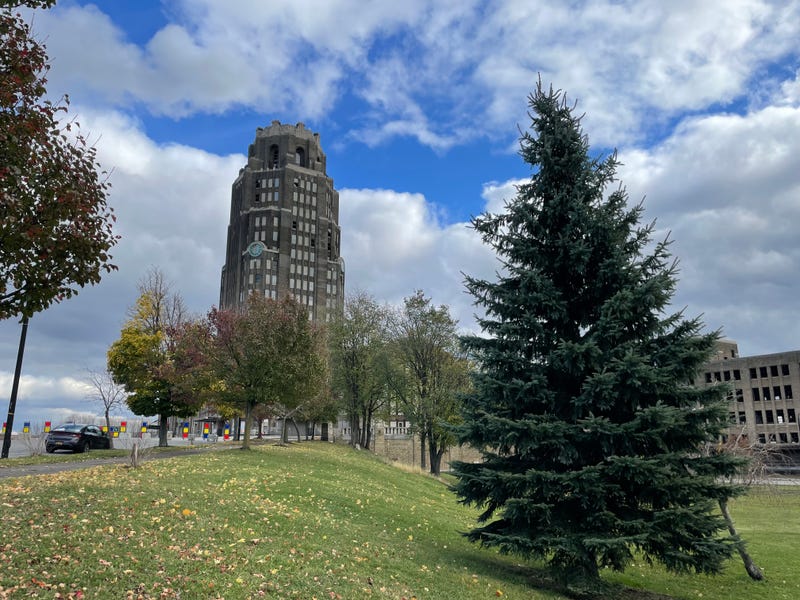
Buffalo, N.Y. (WBEN) - Over the last several years, a number of different groups and organizations have looked into the massive restoration efforts of one of the most iconic buildings in the City of Buffalo: Buffalo's Central Terminal.

Thanks to a massive non-profit effort, tens of millions of dollars in public and private funding has been committed and funneled to the Central Terminal Restoration Corp. in support of future re-development of the Main Terminal building, as well as the Mail and Baggage building and the Great Lawn as a community and economic hub.
However, the property surrounding the Central Terminal has fallen on harder times, with its future far-less set in stone as the Main Terminal building. The former Railway Post Office and Railway Express Agency buildings currently sit in disrepair with roof damage and busted out windows. Farther afield are the former railroad tracks, most of which have been removed and turned into vacant, overgrown land.
Surrounding the location of the Buffalo Central Terminal is the growing Broadway-Fillmore District of the East Buffalo community, which has also received a number of public and private funds to revitalize the neighborhood.
With the revitalization of the Central Terminal and the surrounding areas a central focus in the coming years, 25 graduate students in the University at Buffalo’s School of Architecture and Planning have been crafting proposals over the last few months to transform the land owned by the City of Buffalo adjacent to the prominent Main Terminal building, which covers more than 16 acres of land. These re-development plans are part of a project aimed at creating a more vibrant, inclusive and sustainable Broadway-Fillmore District, and builds on the efforts that are already underway by the Central Terminal Restoration Corporation (CTRC).
"We have an architecture program, we've got a real estate program, and what we really want to do is work together to really make an impact on the city. Lo-and-behold, I saw this summer there's a request for 'expressions of interest,' is what it's called or early proposal stages, to work not just on the terminal, but on the grounds of the terminals. That's the site that's owned by the city next to the terminal. And I thought, 'What more fun could we have with the students to actually look at a project as it unfolds in real life?'," said Assistant Professor of Architecture at the University at Buffalo, Conrad Kickert.
Working with colleague Matthew Roland, Assistant Professor in Real Estate Development, Kickert put together five teams of students from both programs to work on the design of the project, and provide a viable site program and calculate development costs.
"First, figure out what does this area need? We do research, we talk to residents, we did market research, we did historical research. And to then come up with not just nice looking designs, which we are very good at here at the University of Buffalo, but actually viable development proposals, as well," Kickert explained.
"For me, the architects, they do a site analysis, as it's called. For instance, they look at the history, the infrastructure, they look at demographics, and then they make what's called a site design or an urban design. They shape the blocks, they look at the open spaces. ... Matt's class and his syllabus will talk about sort of the calculations, but also the market research."
What Kickert and Roland came up with for this project was sort of a new idea, as they ended up making this into a competition for the teams involved.
"On Wednesday, we have our presentation here at U.B., and there's a jury of five members from the neighborhood, and then one of the members is my dean, Robert Shibley, as well. That jury, not me nor Matt, but the jury will decide who is the winning team," Kickert said. "We start presenting at 3 p.m. and at 6 p.m., we'll have a winner."
Among the jury, comprised of neighborhood stakeholders, includes Central Terminal Restoration Corporation Executive Director Monica Pellegrino Faix, Stephen Karnath - Executive Director of Broadway Fillmore Neighborhood Housing Services, Lisa Hicks of the City of Buffalo’s Office of Strategic Planning, Chris Hawley of the City of Buffalo’s Planning Division, and Alan Oberst - a frequent contributor to Buffalo Rising.
When it comes to the criteria for the competition, it was important for the teams to focus on what the Broadway-Fillmore neighborhood needed, and flipped that into a plan that is viable with architecture and real estate elements involved.
"We did really listen to neighborhood residents, so we focused, for instance, on providing living wage jobs - which, as you know, East Buffalo really, really needs - affordable housing, which the area also really needs. But also, we took a bit of a leap as saying transit conductivity - we're next to Buffalo's main railway station, at least from the past, let's focus on a light rail station there, as well. Let's focus on the green space right next to that beautiful great lawn, so let's integrate that into our site as well," Kickert said. "So we have these sort of criteria for this competition that really bind real estate and architecture together, and I think the teams have really risen up to the task. The designs really show that."
As for the re-development plans and what they are going to cover, it will not be focusing on anything pertaining to the Main Terminal building itself.
"We're specifically focusing on the city-owned site that is Southwest of the terminal," Kickert said. "We did some interesting research. We found that there's a rail terminal on that site that's actually older than the Central Terminal, it's from 1917. There's a post office building that's connected to the Central Terminal. It's a massive site, 16 acres of former rail tracks and these old buildings. So one of the criteria was also, 'Look students, try to do something with these buildings, try to see what we can make work."
Although this is a new concept with this project being a competition, Kickert says he has really enjoyed teaching this class with his group of students. Perhaps what he likes the most is how his students are picking up something that's happening in real life, and trying to emulate that real life as good as they can.
"Again, we are good at making beautiful designs in this school, we are good at making viable real estate proposals. This is really trying to get those two things to work together," he said. "That's what I get the most kick out of, it's to try to get a proposal that really raises the bar on what can happen on this site, but it's also viable. It's not just a pretty picture. So I really liked that. I've done that in the past, in past studios. I've worked in East Buffalo and various other studios, as well. This is really that next level of viability. This is something that can really happen."
As for the students working on this project as part of their capstone course, a lot was running through the minds over the course of this vast concept pertaining to the rich history of not only the Central Terminal, but also the Broadway-Fillmore District.
"I think probably the biggest thing was balance, trying to use the market research that myself and my fellow students did on the Broadway-Fillmore neighborhood, and trying to find ways to really create sustainable, economically prosperous development, while also meeting the needs of what the neighborhood is missing, or does need in order to stimulate the lives of those that are already there," said University at Buffalo real estate master’s program student Enrico D'Abate.
D'Abate acknowledges it was a tedious process for his team when it came to coming up with their re-development plan. He says the toughest challenge initially was trying to find a use for the buildings that currently exist on the site right next to the Central Terminal.
"We did everything that we could to keep them, which in our proposal we did. It involves trying to really take the overall larger square footprint of the building itself and finding the best use for it," he said. "For us, we chose to do industrial uses, as well as community uses in the two buildings that were there. Moving past that, really the next step was trying to create a design and a plan that complemented what already exists in the neighborhood, and would elevate the natural beauty that exists with the terminal on Paderewski."
As their research took them further and further into this process, D'Abate feels the most impactful takeaway he learned was more about the exposure to Buffalo's East Side, as well as the needs of Buffalo's East Side.
"In terms of the real estate side, it was the ability to just adjust quickly when things didn't have to change, because that's often what happens when you do types of projects like this," D'Abate said. "There are just going to be challenges as you go through, especially when it comes to costs, that definitely needed to be considered, and our plan needs to be adjusted over-and-over-and-over again. But luckily, I was in a group of some very strong designers and strong future real estate professionals."
While D'Abate admits he would love his team to be picked as the winning group with their re-development plan for the Buffalo Central Terminal, he says it was the experience itself that he feels already makes him a winner for the long-term.
"Honestly, for me, what I really got out of the project is what's already happened. Just the fact that I was able to do this type of large scale community development project, it's something that I'm very interested in doing moving forward," D'Abate said. "And I think that exposure to being able to build a development project like this is what has been the greatest result of being in this class to begin with. It would be awesome to win too, everyone likes to win. I'm pretty competitive, so I've got a good feeling about our project."
Being originally from Grand Island, D'Abate understands what kind of an impact that projects and plans such as this can have on a community. It gives him a greater understanding of what more can be done to help continue to revitalize areas such as the East Buffalo community and the Broadway-Fillmore District.
"I think the future of real estate in Buffalo is built on its gorgeous and older historic architecture. So the fact that we were able to work on a project that did encompass that, as well as actually doing things that impact the community, that's something that I want to do when I'm an actual professional," D'Abate said. "I think that it kind of hit all of the marks that I was looking for when I first started this program, in trying to positively impact Buffalo, and Buffalo's trajectory moving forward as a city."
